| |
| |
|
 |
| |
|
|
| |
| |
The Electronic Theaters of Woody Vasulka
David Dunn
While the work of the Vasulkas has long been a seminal
influence upon video art, they have maintained an aloofness
to the fashions that have recently compelled that genre.
Perhaps because their work began within the cultural climate
of the 1960s, it has consistently investigated electronic
technology and media as a cultural environment that, for
good or bad, not only carries with it a new visual ontology
but more essentially a potential for perceptual exploration.
All of their work is in some way connected to a fundamental
agenda: to interrogate the intrinsic properties of the machine
as cultural code and the latent or overt perceptual changes
that emerge.
As the retrospective of early video art and technology
that they curated amply demonstrated (Eigenwelt der Apparatewelt,
Ars Electronica 1992), the co-emergence of video art and
solid-state electronics during the late 1960s represented
a unique historical window: the artist and engineer were
inseparable, participating in a collaborative dialogue from
which the systemic identities of the machine and art product
met in an unprecedented mutuality of form and function.
In retrospect it has become evident that this opportunity
for artistic influence of technological innovation occupied
a very narrow slice of time. Within less than a decade,
commercial forces had displaced the artist/engineer with
the mainstream cultural agenda, redirecting artistic innovation
towards satiating the needs of the popular film and broadcast
industries. This situation has only become more acute as
the structure of media tools has moved into a predominantly
digital domain. Technical innovation is now synonymous with
commercially motivated improvement in the production of
mostly cliched and traditional image making while the innovative
artist unsuccessfully plots ways to influence the design
of its digital code.
It is this shift from primary to secondary levels of artistic
participation in the design of media tools that now concerns
Woody Vasulka. Is aesthetic research of the kind that occupied
him for over two decades still possible or even relevant?
In many ways the current installations are an attempt to
address this question and more specifically to explore it
in the context of both the contemporary and recent historical
arenas of the machine as cultural code. In his earlier work
Woody could explore the electronic reconstruction of archaic
perception with a naive enthusiasm reinforced by the immediate
cultural context: the belief in the expansion of human perception
through a technological stratagem. In his current work a
deeper set of references emerge. The didactic purity of
machine as generative source is displaced by the machine
as an environment of problematic semiotic codes that intrinsically
project a self-critique into their sensory enfolding.
In the two installations to be exhibited, a radical philosophical
issue forms the ideological structure that houses a set
of often contradictory references. In The Theater of Hybrid
Automata the core issue is that of physical being in the
light of its virtual representation. Neither in a Platonic
world of Ideal Form where sensation floats free of matter,
pure signification written in numeric code without body,
nor in an Aristotelian ground where language only projects
and reflects its desires upon an imperfect universe, the
robot eye navigates a purgatory of numerical coordinates
to sustain an environment of control systems: a tautology
of self-reference vaguely aware of the intruding spectator.
Rather than an exposition of an electronic theater, it is
a dream of an electronic theater that parodies the dark
side of a cybernetically-controlled environment. With the
eerie efficiency of a high-tech office building after the
workers have left, it rotates through its automatic behaviors,
devoid of human presence yet awaiting the birth of an unknown
form of dramatic action as absolution.
The Brotherhood further explores this conflict between
matter and its representation within a historical frame:
the link between male violence and technology. While this
subject is overt in the choice of the sculptural frame material
that forms the armature within and upon which the media
action unfolds (Case and Rack Assembly Bomb Navigational
Surplus from Los Alamos National Laboratories), it is also
present as embedded content: phallic pneumatic pistons that
control the revelation of circuitry designs related to nuclear
weapons fabrication, sounds of industrial process as ritual
sacrifice, radio transmissions of "friendly fire"
death verifications in warfare, and silent explosions in
animated space as targets for virtual projectiles. All of
these references intersect to form a larger revelation of
the male idea of the machine's destructive potential and
reveal the underlying archetypal psyche without overt horror
or celebration. It is an evocation of an invisible intention
as if this rack was a power object around which hovers the
ghosts of its generative mentalities.
In both of these installations, the role of the viewer
only hints at the current fashion of interactivity. The
audience is not readily invited to control the action like
a video game and therefore enact a preconceived ritual of
pseudo-interactivity. These environments remain autonomous
with only a potential for perturbation by an intruder into
their drama and therefore assert a specific kind of interaction:
these are autonomous worlds that define their closure through
their emergent language, forcing the spectator to swim in
the intrinsic cultural code of the machine.
|
|
Excerpt from a discussion between Woody Vasulka and David
Dunn:
WV: I've incorporated vast amounts of military equipment
into this piece. If you read the label on this table it's
called: "Case and Rack Assembly Bomb Navigational Control."
It's crazy that these things come to my house so I took
this and incorporated it into my targeting system because
this is what it really is. It was designed to navigate bombs
so I'm using it to navigate my pictorial corridors which
are basically trajectories of invisible projectiles.
DD: So that's an overt connection to this idea of Brotherhood
and the machinery of war.
WV: I don't hesitate to speak about it because while I
have always been intellectually opposed to it, in fact I've
surrounded myself with these war machines and have adopted
them. In fact the RPT robotic head in The Theater of Hybrid
Automata is made from a celestial navigation unit that navigated
the bombers for the Strategic Air Command. When I brought
it to Europe and showed it to one of my colleagues in Brno,
he looked at it and said: "now I know what you are
doing because I was an adviser to the Egyptian military
about missile navigation systems." He not only recognized
the Brotherhood but became a "brother" of the
Brotherhood.
DD: So, in your mind, this is becoming explicit as content.
For years you have been working with surplus from Los Alamos
but it was media related as appropriated materials for your
studio.
WV: Now its become very naked as the content itself.
DD: It's certainly upfront in terms of this surplus material
being the detritus of that culture of war. Artists here
have been raiding the Los Alamos scrap yards in order to
make these metaphoric expressions as a kind of critique
of the nexus of science and military cultures. But what
you are doing is taking very specific cast-off materials
and, rather than refashioning them into a sculptural expression,
resuscitating the structural intentions of these devices
as a kind of pure articulation of their generative ideology.
WV: It has exactly the same purpose, to amplify the mind
of its creator: the male idea of the machine's destructive
power. This thing, a vestigial bombing rack, carries the
inspiration with it. When I saw it for the first time, I
knew exactly that this was a piece of that soul. I didn't
even know what it was until I read it later but I understood
it intuitively. When I opened the box, there was a table
with four legs and these racks which I later read were part
of these bombing computers. I envisioned these guys sitting
in the jungle, just before they went to Cambodia, programming
these computers. They were probably dressed in fatigues,
drinking beer, punching the code into computers mounted
on these racks. So I'm trying to replicate exactly the spirit
contained within this piece of metal. It is probably subconscious
but very authentic: these were the machines for automatic
bombing so that no one had to have the consciousness or
responsibility of inflicting death. These codes are hidden
to the general art strategies unless one descends to this
level of intimacy where you recognize by strange instinct
the role of these objects. I think it transfers subconsciously
to the mind of the observer. It is this third level of involvement
that really interests me rather than the obvious one.
|
|
Digital Space: A Summary
David Dunn and Woody Vasulka
Introduction
The concept of interactivity in computer science has generally
referred to issues concerning user interface in the sense
of those parameters of system control over which the user
can exert influence. It is the intention of this proposal
to expand upon this concept of interactivity to address
its broader implications from a philosophical perspective
with regard to the intrinsic properties of what we refer
to as digital space and with specific interest in how such
ideas impact the evolution of art through the existence
of a new technologically derived perceptual environment
for humanity at large. Additionally we hope to outline a
preliminary research plan for the exploration of this perceptual
environment which emphasizes the articulation and design
of syntactical principles essential to this exploration.
While our primary focus is upon the creation of works of
art which would concretize these principles in the form
of aesthetic research, it is our hope that the articulation
of such syntactical principles will also be influential
beyond the artistic domain and have direct application in
such fields as scientific visualization and virtual reality
research.
Interactivity and the Arts
While concepts of computer interactivity have been fueled
and influenced by the creativity and philosophical visions
of artists in the form of science fiction, actual developments
have been dominated by the scientific assumptions of artificial
intelligence research. While the ideal has been to optimally
approach some sort of autonomous coupling between human
and machine through the simulation of human intelligence
and behavioral complexity within the technology, instances
of this goal have not been particularly numerous. Actual
implementation has often only addressed the expansion of
user options within the confines of traditional concepts
of system control. It is our contention that artists need
to participate at the most fundamental level of system's
design before a further advance in the concept of computer
interactivity can unfold.
Our rationale for this assertion stems from a recognition
that the computer signifies a new perceptual environment
(which we refer to as digital space) in the sense of a domain
for the unfolding of sensory, linguistic and social communication
with new characteristics which impact our cognitive evolution,
and that the exploration of this environment cannot substantially
progress without human aesthetic fulfillment. While the
issue of whether or not intelligence can be successfully
simulated through the specification of systemic complexity
within the machine remains an interesting and important
research question for computer science, it cannot be the
determinant of what constitutes the essential criteria of
exploration and humanization of digital space. To this end
we assert that artists must help to shape what is quickly
unfolding as a fundamentally new perceptual environment
which is ushering forth profound epistemological changes.
Our interest and insight into this new perceptual environment
results from our many years of creative use of digital technology
as an aesthetic tool that has often brought us to a direct
confrontation with traditional ways of composing images
and sounds. This conflict has not only been initiated by
our interest in new forms in general but specifically by
the profound implications of organizing our materials through
a numerical code. What becomes apparent from the structural
demands of this technology is that there is an ability and
even an affinity for discrete genre to interact through
the binary code in ways which transcend linear cause and
effect relationships, revealing new compositional concepts
with regard to space, perspective and morphology.
The experience of cinema informs us that the compositional
decisions of editing are constrained by a syntactic set
which results in a concept of narrative negotiable with
an audience on the terms of the author. While this process
seems fully justified for the pursuit of aesthetic communion
within the confines of its medium, the intrinsic processes
germane to the potential for interactivity in digital space
demand other alternatives. The abandonment of a traditional
syntactic set is essential within digital space since its
organization is no longer the exclusive domain of the author.
Since the narrative vectors can be organized by the biases
of an other, new syntactic criteria not only becomes necessary
but unavoidable. These new criteria shift the role of the
author away from merely describing a world for aesthetic
contemplation towards the design of worlds for dynamic exploration.
Additionally this necessitates a redefinition of audience
away from the time sharing of experience characteristic
of cinema and performance to that of an individual who can
exert greater free will in the exploration of an elastic
perceptual environment.
While the use of computers within the arts has long recognized
and taken for granted many of these characteristics, most
computer art and music has not addressed them. There has
been a general tendency to use the computer as a tool to
emulate traditional art genre or extend formal principles
of organization and structure. Many of these limitations
have been structurally imposed in the sense that hardware
limitations have dictated what is possible. With regard
to the concept of interactivity this has resulted at the
most primitive level in providing the user/perceiver with
a sense of choice and/or participatory role in the unfolding
of a narrative or structural change. With the dramatic evolution
in circuit design, computational speed and memory expansion
which have occurred in recent years, new strategies for
interactivity have posed the possibility of artists creating
worlds of sufficient richness to provide the user/perceiver
with a sense of exploring an environment of new sensory
relationships rather than a mere description of such a world.
It is precisely this creative possibility and what it implies
for the perceptual environment of digital space which is
of primary significance. Thus the concept of computer interactivity
can be understood to not only include the interface to a
user/perceiver and the redefinition of authorship which
that implies but more fundamentally to include the potential
for deep structural interaction between the different sensory
modes of human perception. The significance of a serious
aesthetic exploration of these aspects of digital space
extends beyond the domain of art to proffer an expansion
of human imagination through the merger of artistic perception
and scientific process.
Aspects of Digital Space
In contemplating the important aspects of digital space
as a perceptual environment for aesthetic exploration, a
number of essential characteristics become evident. From
our perspective as artists the most obvious possibility
of the computer as a creative tool is its ability to generate
entirely new and unique constructs of sound and image. However
this possibility must be understood in the larger context
of the more profound reality of the structural biases and
potentials of digital space as a perceptual environment.
Perhaps of principal importance are the dual aspects of
random access to stored data and the fact that this data
can be comprised of information corresponding to different
sensory modes of human perception reduced to a common structure
in the form of numerical code. This later attribute is especially
significant in the sense that our usual experience of the
electromagnetic spectrum as divided into discreet domains
of sensory perception (i.e. sight and sound) can be coerced
into an interactive space. The aesthetic and experiential
possibilities which emerge from these characteristics of
digital space are those of the non-linear specification
of events in the sense of a polychronic and polytopic narrative
of image and sound, a non-linear interpenetration between
human sensory modes (i.e. sound controlling image and vice
versa), and the ability to specify and control (either by
the author or the user/perceiver) the characteristics of
change between these various behaviors.
What becomes evident is that a kind of digital synaesthesia
could emerge from this perceptual environment which can
provide an experience of the concept of non-linear complexity
which has become so profoundly significant to the sciences
at large. It is precisely the perceptual issues and problems
which arise in attempting to comprehend this alien domain
which we desire to explore. Since it is these same issues
which face the scientific community from a different perspective,
we understand that such an exploration could have profound
consequences as tools for the perception of non-linear complexity
in science and education. In fact, our interest is in formulating
compositional and syntactical principles which might hybridize
concerns and issues relevant to a variety of research fields
in the context of the necessity for artists to participate,
at the most intrinsic creative level, in the development
of these technologies for the sake of cultural evolution
and preservation.
As already discussed, the characteristics of digital space
which imply new structural possibilities for art are those
of random access, interaction between sensory modes within
the numerical code, and a redefinition of the author's role
towards the specification of a world for potential exploration.
Because of the radical nature of these qualities they demand
the articulation of intrinsic organizational principles
which do not simply borrow from old forms. Since such principles
could constitute what we have referred to as a syntactical
set for digital space in the sense that tonality constituted
a deep structural principle for 18th century music or perspective
for Renaissance painting, it could be argued that the emergence
of such principles might be better left to the self-organizing
capacities of individual creative necessity. It is not our
intention to specify dogmatic rules for the manipulation
of digital space but rather to help set an exploration in
motion which will undoubtedly be transcended by subsequent
explorers.
|
|
go back to Brotherhood Tables
go to top
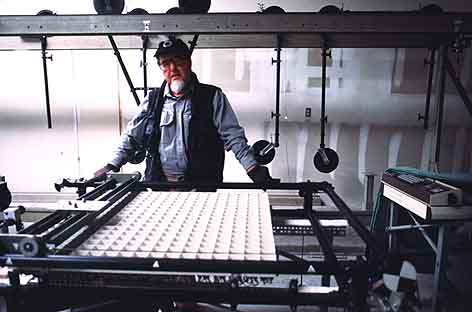
T A B L E I : Translocations
(an adapted plotting Table)

The origin:
I found this large plotting table at the Joe Forth surplus
yard in Buffalo, in the mid Seventies. The unusual feature
of the table was the table itself. It contained 17x17 cells,
each holding a pair of incandescent bulbs. One was connected
to a general illumination scheme, the other was point addressable.
Over a thick matted glass, a strip of mylar drafting paper
had been stretched and transported. The ordinary drawing pen
was positioned and moved by a pair of AC motors. The plotter's
positional feedback was accomplished by a pair of 20turn potentiometers,
locked into XY transport. I suspect the instrument was a wargame
toy to plot an air intercept.
I stripped the unit to bare bones, replaced the AC motor by
stepper motors and my assistant Bill Heckel designed a new
scheme of table illumination and control. It will run by a
small (286) PC computer.
The program:
The traversing arm of the plotter carries now a small monochromatic
camera which can reach each 17x17 light cell under programmed
trajectory. It is looking down on the table for this particular
purpose. I have selected a series of metal edged slides of
early integrated circuit masks designs, a remarkable collection
of artifacts I found in large number at Ed Grothus' salvage
yard.
The Table seems to suggest a form of pictorial memory, which
I plan to evoke by a musical scheme. It is conscious of the
exact location within each cell of the table matrix.
Input/Output:
Inputs: XY stepper motor coordinates
General illumination table control
Point (17x17) illumination table control
Strategy of motion
Outputs:Point (camera) location within the (17x17)
Performance of the motion scheme
Light trajectory and pattern of the light
table (in coordination with movements and
positioning of the camera)
Code exchange: RS-232, Midi, Scores
|
|
go back to Brotherhood Tables
go to top
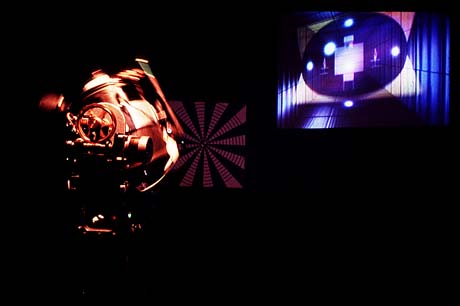
T A B L E II: Automata
The Theater of Hybrid Automata consists of and operates in two
dialectically engaged spaces: the actual and the virtual. At
the core of this space-exploring machine is a RPT (rotate, pan,
tilt) robotic head capable of moving a video camera through
an unlimited orbital range of all three axes. A pair of opposite-facing
infrared transmitters are in position to calibrate and synchronize
the motion control motor drives with a related visual representation
of the abstracted space, stored and retrieved from laser disk.
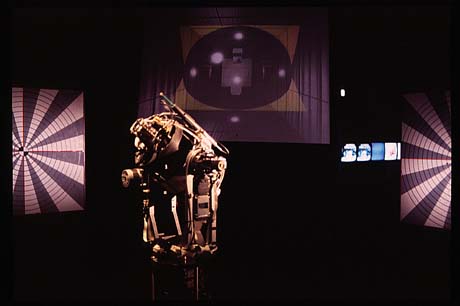
|
|
go back to Brotherhood Tables
go to top
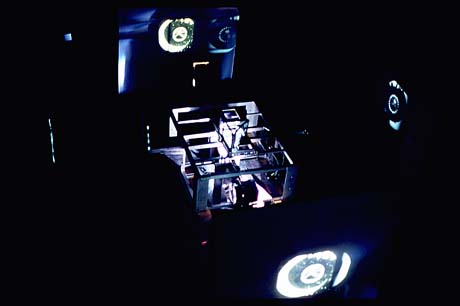
TABLE III: Friendly Fire
Origin:
This table is another Los Alamos scoop. The already empty
aluminum cages originally contained bombing computers from
the Vietnam war. The cages, showing an IBM tag, could convert
the top lid into a true tabletop with the legs attached and
folded into the lid. I suppose that on the battlefield the
targeting personnel would open the box, spread the legs below
and put the contents of the cages on the tabletops. There
were no chairs in the package. It was this elegant table arrangement
that became my inspiration for the six installations.
I use split-image-half-mirrors to get a six axes image distribution.
There were to be several layers of screens collapsing onion-like
one by one, but I eventually settled on two layers only.
Images come from two sources: A Random Access Slide Projector
and Video Projector. The Slide Projector is a work of art.
It must have been associated with some form of digital memory
function. The set of slides coming with it had a character
of calibration grids, Eastern Airlines' Logos or some secret
Brotherhoods' coat of arms. It looks like these were projected
on a storage tube. I found it in a Junkyard near Horseheads,
New York.
At this time it is not possible to fully describe the function
of this table. I know the table will carry five collapsible
frames placed on the edge of the table, operated pneumatically.
It will time-share the split-image-half-mirror arrangement
and will present expanded and compressed corridors with moving
gates, opening or closing, close to the center or further
projected. The sounds will suggest the echo of space, following
the transformation of space.
There is a specific work with light, filtered through metal
coded mirrors, giving the scene an almost theatrical character.
Input: Slides, Laserdisk Moving Images, Sampled Sounds,
Lights, Sensorial proximities
Table III (Functional Description):
Table III holds two picture delivery arrangements: the first
is a Random Access Slide projector while the other is a video
projector. Each of these systems is associated with a family
of images that occupy a specific projection environment: the
stills are confined to a small six screen layout while the
moving images occupy an extended projection environment. Both
kinds of projections share the identical pathway of a six-way
beam splitter with the images distributed along six axes of
cubical vectors to the six screens. During the still image
sequence, the projection is intercepted by smaller screen/frames
defining its own projection environment out of the general
space. These small frames fold, freeing the projection path
for the moving image sequence.
This extended projection environment is defined by an arrangement
of six projection screens, four standing on the floor plus
one suspended from the ceiling. The character of the screen
material lets the images appear on both sides, extending the
installation's observation mode from the inner confined core
to that viewed from the outside. There the installation becomes
an object with a multitude of interrelated images.
The installation has additional functional elements of sound
and interactivity. These provide a mode for determining the
observer's presence and a certain level of participation.
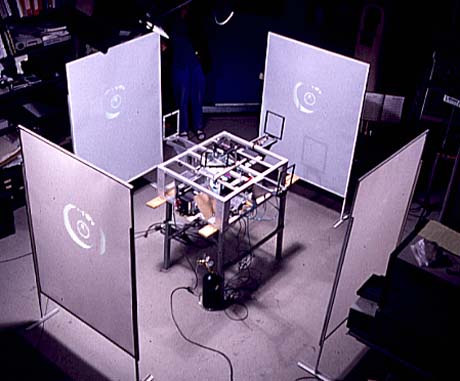
|
|
go back to Brotherhood Tables
go to top
T A B L E IV: Stealth
This table is a clear flash-back to the sixties. Steina had
gone to Paris to study still more violin, so I moved in with
Alphons Schilling to a former Rauschenberg loft on Front street.
We both had been experimenting with the movies, we both knew
there was something fundamentally wrong with cinematic frame
or rather with any frame around an image. We put the camera
on a turntable and began to struggle with deconstructing the
space around it.
Alphons when not angry, was a magnificent companion. He showed
me the ropes of the art world and against my will, he pulled
me across the schism of the shy socialist upbringing to the
arrogant and self assured NY artist’s identity...
Naturally, we prowled the Canal Street junk shops, bumping
into Paik and the others. The first big thing found was a
large box of infinitely intriguing interlocking gears. When
I read the labels, I undated it to be a WW2 bombing device.
I learned later from John Whitney that it was the same device
the family used in making first computer films. I built a
stereoscopic table for Alphons from it and he still shows
it in his catalogs.
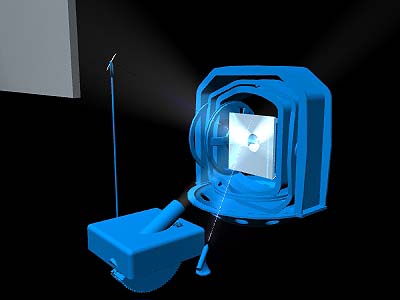
|
|
go back to Brotherhood Tables
go to top
T a b l e V : Scribe
(Letter writing Machine-DATASCRIBE III):
Words activated writing
History:
Found on the L.A. Surplus yard 1992, purchased for $3 in
good working order. Went through further adaptation. Continuous
ink feeder from medical plastic container added, sound pick-up
of stepper motors added, continues feed of writing medium
designed and constructed.
Input:
Keyboard, Voice to Code (speaker independent speech recognition
resulting in drawn characters - words,
File source
Output Functions:
Letters/text drawing
Generating of musical sounds (from the stepper motors)
Pick-up of table activity by a camera, projected
Scheme:
Observer interactive associated hardware:
Pen Inkfeeder
Writing medium transport
Video Camera
Video projector
Projection Screen
Computer with speaker independent software
Microphone with stand
Lights with interface
Environmental Sensors
Sound Sampler (sound storage/retrieval)

|
|
go back to Brotherhood Tables
go to top
T A B L E VI: The Maiden
THE MAIDEN
by Melody Sumner Carnahan
Operations: the attached valve implement allows her
to fill hollows in response to changes in size and body-weight.
Gas-charged stabilizers offer an advance in performance by
encouraging quasi-consistent reactions to mood irregularities.
With steady-state priming, an extra-dense cone apex, a long
straight nose carved in facts that catch the light, she makes
use of non-zero cushioning to eliminate fade and prevent bottoming.
The fins may later be removed and placed in a vault; her attraction
henceforth based on cruelty and grand austere lines.
Coil springs and absorbers are positioned between her frame
and her arms. Springs relieve the hysteretic effects and absorbers
dampen the springs - for increased control capacities. Ball
joints placed between the steering knuckles and the control
arms support her weight, restricting wobble. Incorrect camber
results, at times, in excessive wear on one side. Negative
camber can be hardened using the standard-supply hardening
tool. Torque is distributed to the rear through her elemental
half-shafts and constant velocity receivers. Since the inhibition
curve cross-sections huge concussing tempus-fugit tubes, it
will not be feasible to establish the quantitative character
of her world trade centers at this time. Anomalous curves
must be judged on the basis of physical uncertainties. Any
design that incorporates clouds of indifference, as well as
some form of rear arch, will overcome existing limitations,
allowing her to smirk and refrigerate disease.
Error Handling: With this new construction, high-pressure
throttle membranes successfully contain all poaching fluids
in place. However, if turbulence is advanced, a rupture in
her cups results when the scored solids normally carried away
by the vertically-rising stream are returned to the fuel tray
through a classifier arrangement. With a drop in core permeability,
pencil factories are eliminated. It is permissible then to
add in additional glass, grease, gears, and wind. When her
middle begins to bulge, inaugurate the tripod-widow selenium
wisdom clip. Saturation can then be abruptly limited, in accord
with the manner in which her saturation curves were originally
drawn. From a practical standpoint, unwilled states of being,
with ambiguous emotion, result as a break-over from the funicular
to the pendular. It would be a relatively simple matter to
inhibit the pendular if her fluid reservoir boundaries were
known. As is, the clicker device, attached by isomorphic shafts
to the steering knuckles at their edges, sheds light on disappearing
shipments, making sure she goes nofarther than too far.
During the early wetting phase, events occur as afterimages
of precise intentions. Absolute thickness is determined by
blind geometry. The horizontal return-tubular - HRT as represented
in the diagrams - is one of the oldest fin-type tubes used
in her configuration. Its performance can be improved with
the addition of small-diameter rack compressors and habitual-pattern
diffuser attachments, which offer the broadest application
for ongoing stability (currently offering thirty-five levels
of undo). Since recovery is always accompanied by an expenditure,
permissible loss should be charted ahead of time.
History: At the center of her configuration, we find
a crude rendition of creative thought. A device reads the
terrain following the operating principles of closed-system
dynamics. Utilizing a physicality plotted as a solid in dimensionless
form, she contrives a source of pleasure at the edges of her
boundaries, providing someone hasn't told her she is only
a girl. Everything at first is dark, fluid, pneumatic, in
motion, facilitating a metaphysical flood in an ethics of
privacy.
As her drama progresses, it relates only to itself, mapping
its own indigenous autistic information system. Ensconced
in a philosophically astute mechanism, with sensuous teacups
infinitely repeated, she soon is able to guide her own doom.
Cognizant instruments firmly in operation provide a calendar
of her sex life, as she navigates various medical flesh uniforms.
Information distributed widely to individual receivers accumulates
as volume, pooling into assumptions about what is person al
to her. Each image-making apparatus presupposes its own image
contains themost significant information. She locates herself
as the center of the configuration, rushing forward or holding
back to engage the incongruous and to permit multiple occurances
of the ultimate driver.
Deployment: She must maintain a lubrication schedule,
periodically check that the flip/flop gate in her discharge
spout is free, make certain that the seals on her roller journals
ride firmly in their saddles, keep accurate records of the
tons she has pulverized. If capacity drops, you will need
to manually readjust the clearance between her rings and her
rollers. At such time, it may be desirable to improve her
image with lacquer or lamination. If necessary, the factor
placing a limit on surface interface can be kluged as a source
of exit contemplation.
Her acute rhetorical telos system continually targets the
cardinal points, emphasizing a notable decrease in verbal
acumen as humanity sinks to its lofty plateau. Her framing
mechanism closes in on a vast proscenium that lets in the
last American. Her normal shutdown sequence reverses the start-up
sequence: a container de-hallucinating barriers in conversation
with fields of time. Between successive disconnects, a lag
must be employed to insure complete clearing of all displays.
Determine by experimental operation the correct bed thickness,
one that conforms to primordial patterns of operation. In
her final moments, one new word can be gained in exchange
for the entirety of history. However, her gestures will then
become too large or too slow, with the resulting collapse
of long, loose columns of snow.
One More Thing: Always reserve a margin for emergency
shutdown. In the event that emergency shutdown fails, sacs
of condensed explosives, with carbon sensors sewn in, will
erupt from her reconstituted fins for a massive triggering
of prolix outcomes. Without stripes or fears, with no visible
signs of aging, her blindness to the double-bind she's in
metastasizes into a mission of destruction more bitter and
sincere than caves of empathy visited once in a lifetime at
an elevated, skeletal location. Inoperable venom replaces
her impassive beauty, while her latent states make a virtue
of toying with dismemberment.
To implode super-loaded male fantasies, the maiden-in-flight
emerges from the other end of the tube dressed in the stink
of decay. From sperm to worm inside an hour, her cellar fills
with animal pelts, blood rains down on the threshing floor,
and her flower bursts its atomic core. Here, the maiden cashes
in her chips: she condemns the carbonaceous allotropes she
has engendered; she gives in to her jaded, uncomely jailer;
she allows the frozen ground to flail her, as fingers of carcinogens
strip off in ribbons what remains of her soft skin.
[The text of The Maiden, was adapted by Sumner Carnahan
for the Brotherhood in 1998, from the original text titled
One More Thing, commissioned by Laetitia Sonami for
live performance.]
For information on Melody Sumner Carnahan's books and CDs
contact Burning Books: [email protected]
|
|
|
|
|